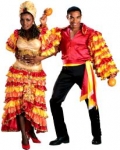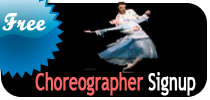
Pierre and Lavelle introduced the true "Cuban Rumba Dance Style" which was at last established after long argument, as the official recognized version in 1955.
The "rumba influence" came in the 16th century with the black slaves brought in from Africa. The native Rumba folk dance is fundamentally a sex pantomime danced enormously fast with exaggerated hip movements and with a sensually belligerent attitude on the part of the man and a defensive attitude on the part of the woman. The music is played with a staccato beat in keeping with the energetic expressive movements of the dancers. Accompanying instruments comprise the maracas, the claves, the marimbola, and the drums.
The word Rumba is a generic word, covering a range of names (i.e., Son, Danzon, Guagira, Guaracha, Naningo), for a kind of West Indian music or dancing. The accurate meaning varies from island to island.
There are two main sources of the dances: first one Spanish and the other African. Though the main growth was in Cuba, there were alike dance developments which took place in other Caribbean islands and in Latin America usually.
In Europe, the preface of Latin American dancing Rumba in particular owed much to the eagerness and interpretive ability of Monsieur Pierre, a leading London teacher. In 1930's with his partner by name Doris Lavelle, he demonstrated and made Latin American dancing popular in London.
Rumba is the strength and soul of Latin American music and dance. The charming rhythms and bodily expressions make the Rumba one of the most trendy and well-known ballroom dances.








